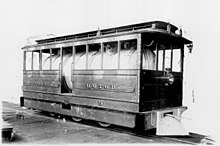Lyndale Railway Company
| Lyndale Railway Company | |
|---|---|
|
Minneapolis, Lyndale, and Lake Calhoun Railway locomotive called 'engine' | |
| Route length: | 7.25 km |
| Gauge : | 914 mm ( English 3-foot track ) |

The Lyndale Railway Company , later renamed the Minneapolis, Lyndale, & Minnetonka Railway Company , operated the Minneapolis , Lyndale and Lake Calhoun Railway , also known as the Motor Line .
history
The Lyndale Railway Company built a railroad line that began on First Avenue and Nicollet Avenue in downtown Minneapolis and ran west along what is now 31st Street on Hennepin Avenue, then turned southwest and ended at Lake Calhoun. West of Hennepin Avenue, the train operated with a 'Right of Way' over private property. The company also built a pavilion on the shores of the lake near the end of the railroad's endcock yard.
The 7.25 km long narrow-gauge railway with a gauge of 914 mm (3 feet ) started operating in 1879. Two two-axle steam locomotives, which looked like trams through their wooden superstructures, pulled short trains on this railway line.
The railway line was extended to Lake Harriet in 1880 and to Excelsior on Lake Minnetonka in July 1882 . In passenger transport, she transported excursionists to relax on the banks of these lakes.
In December 1885, the railway company experimented with electrification based on the Charles Van Depoele principle , but decided that it was not yet mature enough because the engines in the prototype vehicles vibrated heavily and had other mechanical problems. The company started using two soda locomotives built by Baldwin Locomotive Works in Philadelphia from 1886 , according to reports the first and probably only soda locomotives built in the USA, while soda locomotives had already been imported for the elevated railway in New York City .
The company was never profitable, however, and was sold to James J. Hills St. Paul, Minneapolis, & Manitoba Railway , the forerunner of the Great Northern Railway , in 1886 when tourist traffic subsided . The track was retrained to standard gauge and extended to Hutchinson , but the line from Lake Harriet to Hopkins was taken out of service. The steam locomotives were unpopular in the city, so profits continued to decline and the line was leased to the Minneapolis Street Railway in 1887 . Route use was further reduced, and the route to Lake Calhoun and Lake Harriet was closed.
literature
Munn, MD: Articles of incorporation, by-laws, and ordinances of the Twin city rapid transit co., Minneapolis street railway co., Minneapolis & St. Paul suburban railway co., St. Paul city railway co. 1899 ( catalog entry ).
Individual evidence
- ^ Connecting Lake Harriet and Lake Calhoun. ( Memento of the original from February 23, 2014 in the Internet Archive ) Info: The archive link was inserted automatically and has not yet been checked. Please check the original and archive link according to the instructions and then remove this notice.
- ↑ George Woodman Hilton: American Narrow Gauge Railroads . Stanford University Press, 1990, ISBN 978-0-8047-1731-1 , p. 428.
- ^ Como-Harriet Streetcar Line History. ( Memento of the original from September 20, 2015 in the Internet Archive ) Info: The archive link was inserted automatically and has not yet been checked. Please check the original and archive link according to the instructions and then remove this notice.

